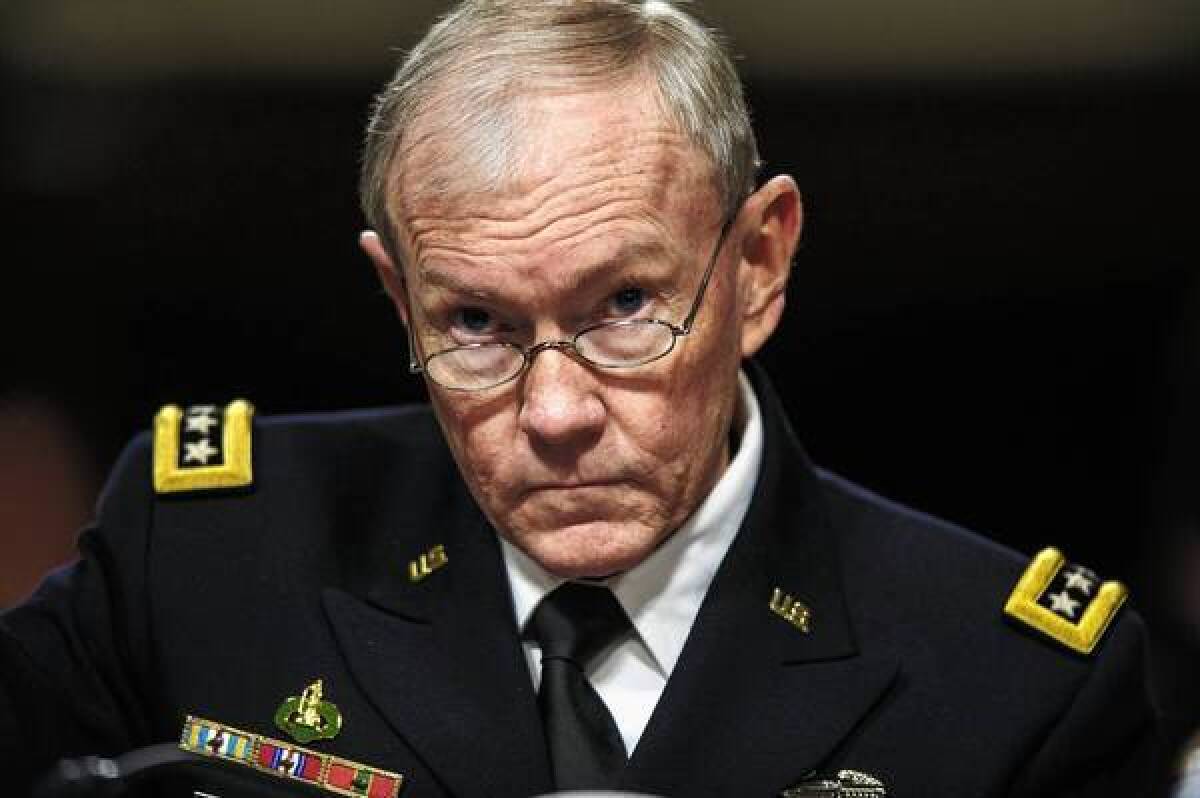Joint Chiefs head outlines risks of Syria options

- Share via
WASHINGTON — The Pentagon’s top officer said in a letter released Monday that U.S. intervention in the 2-year-old civil war in Syria would probably strengthen the rebels and put intense pressure on the government there, but he warned that even limited military involvement could backfire.
Army Gen. Martin Dempsey, chairman of the Joint Chiefs of Staff, outlined five options that he said the U.S. military could carry out if ordered by the White House: stepping up training and advising of the rebels, conducting limited airstrikes, establishing a no-fly zone, setting up a buffer zone inside Syria outside government control and securing Syria’s chemical weapons stockpile.
Dempsey described the options and the risks that each carries in a letter to Sen. Carl Levin (D-Mich.), chairman of the Senate Armed Services Committee. During a hearing last week on Dempsey’s nomination for a second two-year term, Levin had asked for steps the U.S. could take on Syria.
Dempsey said there were “ongoing deliberations” over the U.S. role in Syria within the Obama administration, which announced two months ago that it was stepping up military aid to the rebels after concluding that President Bashar Assad’s government had used chemical weapons.
The limited U.S. effort to train and equip rebels so far has been handled by the CIA. Bringing in the military to conduct training would take “several hundred to several thousand” U.S. troops in safe areas outside Syria and cost $500 million a year, Dempsey said. It would carry the risk that extremists fighting on the side of the rebels would gain “additional capabilities” and raise the possibility of cross-border attacks by Syrian government forces.
The U.S. could also opt for strikes using aircraft and missiles fired from outside Syria, which could potentially hit “hundreds” of military targets and significantly degrade the government’s strength over time, he said. But doing so would take hundreds of aircraft, ships and submarines. Syria could potentially “withstand limited strikes by dispersing its assets,” he said.
A no-fly zone over Syria would prevent Assad’s government from using its aircraft to bomb rebel-held areas and resupply its troops. But it would require hundreds of aircraft, based at sea and in nearby countries, and cost as much as $1 billion a month, Dempsey said. The U.S. could also lose aircraft as it sought to eliminate the government’s air defense system, and “it may also fail to reduce the violence” because most attacks on rebels are conducted by Syrian ground units, not aircraft, he said.
The creation of buffer zones in Syria near its borders with Jordan or Turkey would allow rebels to train and permit distribution of humanitarian aid, Dempsey said. But setting up such a zone would require a limited no-fly zone as well as thousands of U.S. troops, costing more than $1 billion a month.
Controlling Syria’s chemical weapons stockpiles would require air and missile strikes, as well as thousands of special operations troops, Dempsey said. “The impact would be the control of some but not all chemical weapons,” he said.
U.S. intervention would “likely further the narrow military objective of helping the opposition and placing more pressure on the regime,” Dempsey said. But he also warned that intervention would bring unanticipated consequences, echoing the cautious stance of the Obama administration, which has played down the prospect of direct U.S. military involvement in the war.
“Should the regime institutions collapse in the absence of a viable opposition, we could inadvertently empower extremists or unleash the very chemical weapons we seek to control,” Dempsey said.
At a security forum last week, David Shedd, the No. 2 official at the Defense Intelligence Agency, said the Islamist militants among the Syrian opposition were becoming increasingly powerful and dangerous.
“The reality is that, left unchecked, they will become bigger,” Shedd told the Aspen Security Forum, an annual conference on security issues. “Over the last two years they’ve grown in size, they’ve grown in capability and ruthlessly have grown in effectiveness.”
More to Read
Sign up for Essential California
The most important California stories and recommendations in your inbox every morning.
You may occasionally receive promotional content from the Los Angeles Times.










